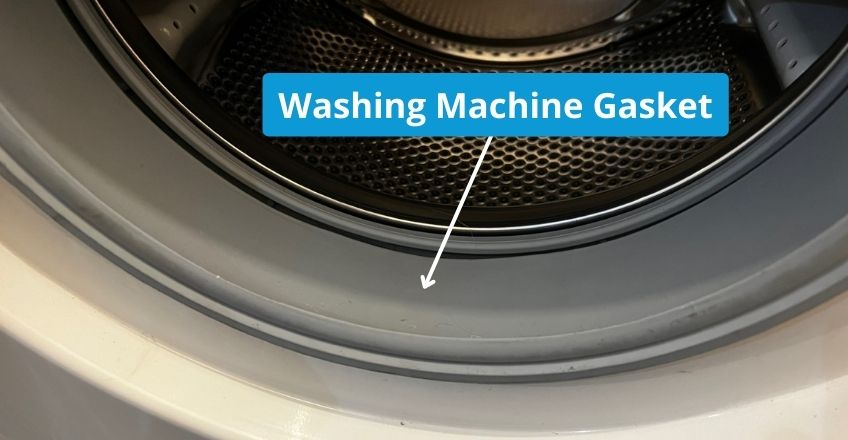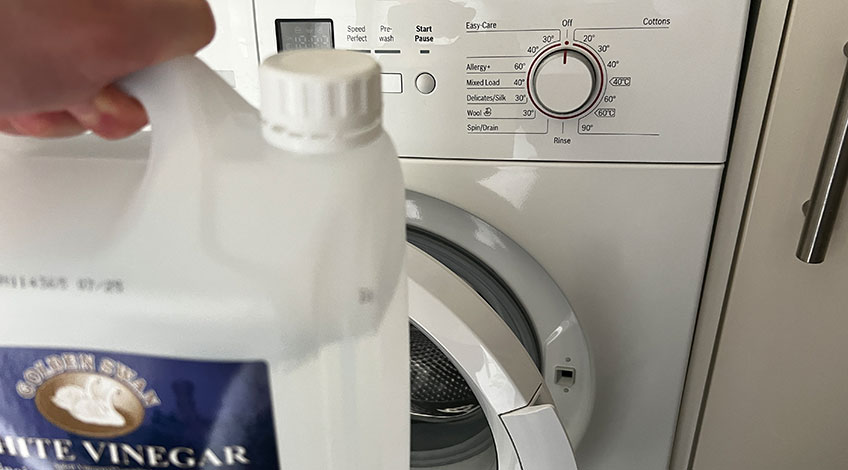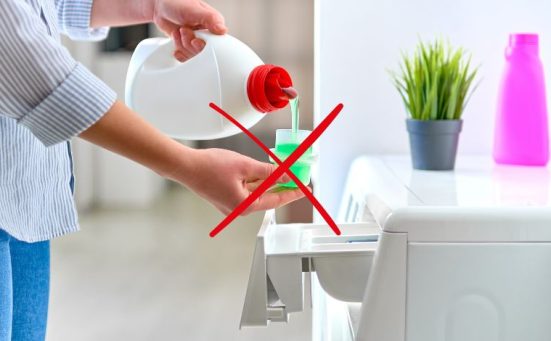
What Is A Washing Machine Gasket? (& how to clean, maintain & replace it)
A washing machine gasket is the rubber seal that fits between the drum of the machine and the door. It’s there to prevent water leaking out and flooding your floor during the wash and rinse cycles.
In this article we take a closer look at washing machine gaskets and find out exactly what they are, how to replace them if they leak and much more.
What Is A Washing Machine Gasket Made From?
Washing machine gaskets have always typically been made from rubber which moulds into the correct shape to seal the drum once the washer’s door has been closed.
However, washing machine manufacturers are moving away from traditional rubber to make the gasket from, and are increasingly turning to ethylene propylene diene monomer (EPDM) rubber (synthetic rubber).
This synthetic rubber is more environmentally friendly and in many ways, reacts better to the stresses and strains exerted by the spinning drum as well as being highly tear resistant.
Whether the gasket in your washer has been made from rubber or a synthetic rubber, it will have been shaped to ensure a strong seal between the door and the drum of your machine.

What Can Damage The Washing Machine Gasket?
Washing machine gaskets are relatively tough and resistant to the stresses and pressure applied during a typical wash cycle. However, they’re likely to become worn over time and are also likely to damage if caught with something sharp.
Anything from zips to buckles, including screws, nails, bra wires or even keys can cause the gasket to leak. The gasket could also develop a leak if it were to crack. Cracking can occur if the gasket is exposed to UV light from the sun for instance.
Sunlight will discolour the gasket over time and cause it to dry out and crack. Any cracks or rips or tears, even minute puncture holes will eventually lead to the gasket leaking.
Should You Replace A Damaged Washing Machine Gasket?

To prevent leakage, you will need to replace the gasket on your washer if it starts to crack or you notice any holes appearing. Washing machine door gaskets are relatively cheap to buy and range in price from around £15 to £90 depending on the make and model washer you own.
You will often need to replace the seal clamp as well which will cost around £10. So, for around £100 your washer will no longer leak and depending on how old it is and which brand, it should give you many more years of service.
If you don’t feel confident enough fitting a new gasket yourself, you can call in a technician. But that will cost anywhere between £50 to £100 and needs to be factored into the overall cost of replacing the gasket.
However, it’s at this point that you need to ask yourself a few questions to work out whether it is actually worth replacing the gasket or buying a new washer. We know that washing machines have a typical life expectancy of around 10 years.
You will need to work out how old your washer is and if it’s less than 5 years old, it’s most probably worth fitting a new gasket. However, an 8 or 9 year old washer probably isn’t worth spending upwards of £100 on.
That money would be far better put towards a new machine. Especially if you intend to employ a technician to fit the new gasket.
How To Fit A New Washing Machine Gasket
If you do want to replace the gasket yourself, it’s a fairly straightforward job. If you have a few basic DIY skills and a screwdriver you should easily accomplish this yourself.
To fit a new gasket to your washing machine all you need to do is;
- Disconnect the power supply
Before attempting any repairs you should always remove the plug from the wall socket or switch the circuit breaker to the off position. This cuts the flow of electricity to the appliance and will protect you from any shocks. - Remove the washer’s lid
To remove the lid you will need to unscrew the 2 screws at the top back of the machine. You should then be able to gently push the lid backwards slightly and lift it away. - Remove the front top panel
Remove the soap dispenser drawer (look for a button towards the back of the drawer, press this button to fully remove the drawer). Then unscrew the screws at the top and front of the panel. Take care when removing the top panel because there will be connections for the control panel in this vicinity. - Remove the front lower panel
Open the filter door and remove the screws, this should free the lower panel. - Remove the front middle panel
This is the most complex part of the operation. The first step is to remove the band that is clamped around the gasket holding it to the drum. Once removed, fold the gasket into the drum and then unscrew the screws at the top and bottom of this panel. Take care when removing this panel, as you will need to disconnect the wires connected to the back of this panel. - Remove the gasket
Locate the second clamp that’s holding the gasket to the drum by loosening the screw. Once the band has been removed, the gasket can be unclipped and pulled out. - Fit the new gasket
To fit the new gasket you should use a small amount of washing up liquid to grease the edge of the drum. Then fit the gasket onto the drum ensuring that the drainage holes are in the correct position and replace and tighten the clamp band. Ensure the gasket is firmly in place and then fold it into the drum and replace the front middle panel (remembering to reconnect the wires). Once the front middle panel is back in place,bring the gasket out of the drum and tuck it into the outside edge. Then replace the other clamp band and tighten it securely. - Reassemble the rest of the panels
Now it’s just a case of reverse engineering the panels and detergent dispenser drawer.
Please Note: There are some washing machines that don’t have removable front panels, if this is the case, you will need to remove the top of the machine before carefully laying the appliance on its back and then removing the door to access the gasket easier.
How To Clean The Washing Machine Gasket

If you have inspected the gasket on your washer for wear and tear or cracks and you have noticed mould patches, you’ll need to remove it to prevent your washer from smelling.
To remove mould or mildew from the gasket you will need something fairly strong. There are a couple of ways to do this which are;
Using Chlorine Bleach
Using neat bleach could be detrimental to the rubber gasket so you should always dilute it by mixing ¾ cup (180ml) of chlorine bleach into 1 gallon (3.8 L) of warm water. Mix together well, and then dip a cloth into the solution and wipe all of the gasket. Remember to lift the gasket to ensure you cover the whole surface.
Leave to soak for 10 minutes to kill the mould, mildew and bacteria and then using a clean damp cloth, wipe away all of the bleach and mould.
If some of the mould remains, you can use a small amount of the bleach solution on a cloth and apply it to the affected area.
Using White Vinegar & Bicarbonate Of Soda
If you don’t want to use chlorine bleach and prefer a natural solution, you can sprinkle bicarbonate of soda all around the gasket. Then using a spray bottle, spray distilled white vinegar into the same area.
You should then scrub the gasket using a soft brush or toothbrush to remove the mould. You then need to remove all of the vinegar from the rubber gasket using a clean damp cloth.
Vinegar will often work better and is safer than using bleach. Vinegar is also more effective at removing soap residue and mould.
Please Note: You should never mix bleach with vinegar or any other chemicals as it could produce harmful vapours. Vinegar can also cause the rubber gasket to perish which is why it needs to be thoroughly wiped away after application.
How To Prevent Mould, Mildew & Bacteria From Building Up In The Gasket
As with most things in life, prevention is better than cure. To prevent the gasket from becoming a breeding ground for mould, mildew and germs & bacteria, there are a few things you can do. Which include;
- Wiping the gasket dry after every wash
You should always use a clean dry cloth and wipe the gasket after every use to ensure that it is dry. As mould, mildew and bacteria are more likely to grow in damp conditions, this reduces the chances of the drum smelling. - Leaving the washer door open when not in use
After using the washing machine and drying the gasket, it’s a good idea to leave the door of the machine open so that it can fully dry out. This will also reduce the risk of mould, mildew and bacterial growth. - Never leave wet laundry in the drum
The best way to prevent your drum from smelling and keep the door gasket free from mould is to keep the washer as dry as possible between washes. A good way to do this is to never leave any clothes, wet or dry, in the drum when the appliance isn’t in use. - Never use more detergent than is needed
Using too much detergent will result in soap scum or detergent residue forming around the gasket. You should always use just the right amount of detergent, and the correct type of detergent for the wash load you’re doing. - Keep away from fabric softener
Fabric softener also leaves a residue behind which attracts mould, mildew and bacterial growth. If you need to soften your clothes, use white vinegar in the rinse cycle or add dryer sheets to the tumble dryer.
We hope that you’ve found this article helpful and informative. If you have any questions feel free to ask them in the comments section below.
SEE ALSO: How To Use White Vinegar In The Washing Machine (and why!)
Frequently Asked Questions
You can replace the washing machine gasket yourself and it’s reasonably straightforward on most washers. You will need to dismantle parts of the body of the machine to gain easy access.
The large rubber seal around the door of your washer, is the washing machine gasket.
The cost of replacing the rubber seal or gasket on a washing machine in the UK is anywhere between £75 to £200 depending on the make and model of appliance you own. For example, Beko door seals cost around £15 to £25 whereas Bosch door seals on some models cost in excess of £100.
Also, follow us on Pinterest ...



